The winner – Mailchimp
Life-changing superhero
In this comparison, Mailchimp wins eight out of eleven rounds. One round ends in a tie, and there are only two aspects where Flodesk outperforms Mailchimp. Continue reading to find out more.
What Mailchimp features are better than Flodesk?
- Marketing automation templates and features
- Segmentation
- Advanced reporting
- More integrations with other platforms and tools
- There is a very small selection of automation templates
- Segmentation is very basic; doesn't offer email activity and demografics criteria
- Reporting is quite basic, suitable for the very beginners
- There are only few integrations available
When it comes to email marketing, Mailchimp is the software that immediately comes to mind. Since 2001 the platform has transformed into an all-in-one marketing platform with an extended list of functionality for all kinds of businesses.
However, if you are a solopreneur, blogger, or educator seeking affordable alternatives, consider Flodesk. An email marketing platform launched in 2019 and designed for creators.
Flodesk is known for its visually appealing and intuitive email editor, making creating beautiful and modern email campaigns easy. On the other hand, Mailchimp is a more established platform with a wide range of features and integrations.
The choice between Flodesk vs Mailchimp depends on your specific requirements and budget. It’s essential to consider factors like ease of use, design capabilities, automation features, and pricing before deciding.
Read on to understand what features make these two platforms unique and prepare to make an informed choice.
Flodesk vs Mailchimp: Quick overview
Users appreciate Mailchimp’s ease of use and strong customer support. Moreover, Mailchimp has powerful automation capabilities and offers various pricing tiers. For more detailed information about Mailchimp, check out our in-depth Mailchimp review.
However, numerous merchants have expressed concerns about “hidden fees” and elevated costs. We’ll take this up in detail later in the article.
Regarding Flodesk, on the other hand, users typically vouch for its advanced email builder and modern-looking templates. Flodesk also offers a flat-rate pricing model, making it cost-effective for businesses with more extensive subscriber lists.
So which tool’s right for you — Mailchimp or Flodesk?
Before an in-depth comparison, let’s briefly examine their key features.
Flodesk vs Mailchimp: Feature by feature
Tool comparisons help you to identify strengths and weaknesses, helping you determine if a particular software meets your goals.
Additionally, comparing features can reveal if certain functionalities are essential for your operations or if you can do without them, potentially saving costs.
So, let’s begin our Flodesk vs Mailchimp comparison.
Ease of getting started
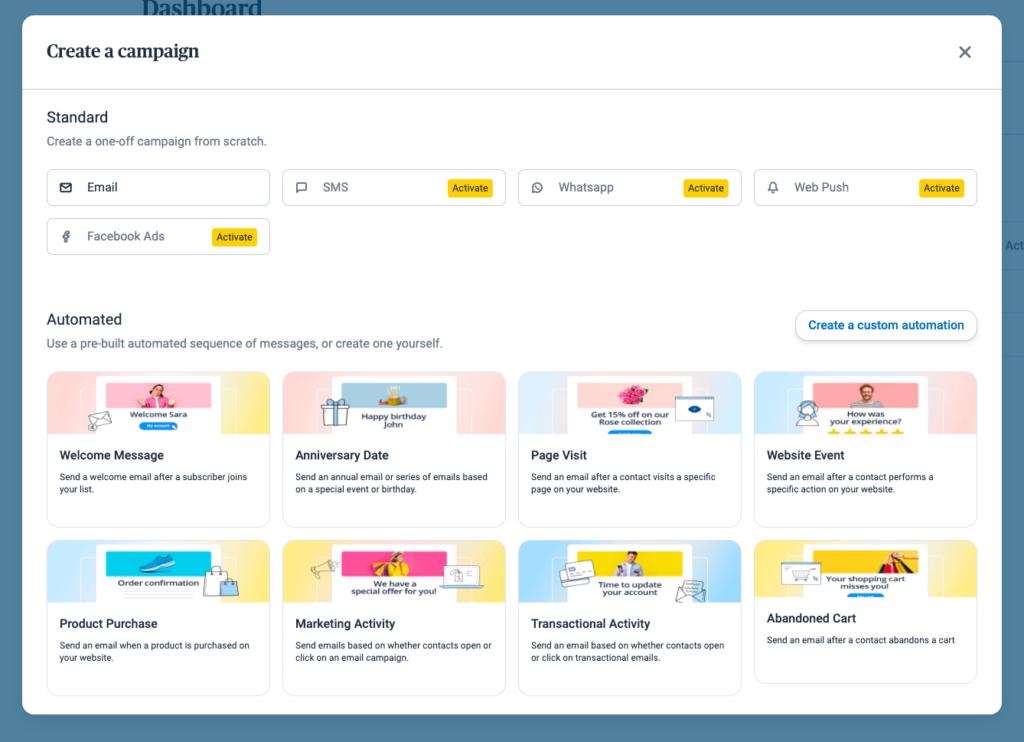
Starting with Mailchimp is straightforward and user-friendly. It feels easy partly because the platform provides a checklist to help users get started. They also offer a generous 30-day free trial to explore and test its features.
Like Mailchimp, Flodesk also provides a 30-day free trial. Setting up the platform, changing the sender’s email, and finding all the necessary features is easy.
Furthermore, Flodesk’s free trial doesn’t require credit card information, unlike Mailchimp, which does.

Both platforms’ designs are clean and intuitive, but Flodesk’s interface stands out with its minimalistic design.
Mailchimp offers a wide range of functionality, but this abundance can sometimes make certain features challenging to locate. We faced difficulty when trying to change the sender’s email address. Finding the right functionality proved a bit challenging.
It’s a draw. Mailchimp may be a bit challenging to navigate, but it offers guidance. On the other hand, Flodesk’s clean interface is so user-friendly that users might not require any direction in the first place.
Building an email campaign
It’s pretty easy to create email campaigns on Mailchimp and Flodesk.
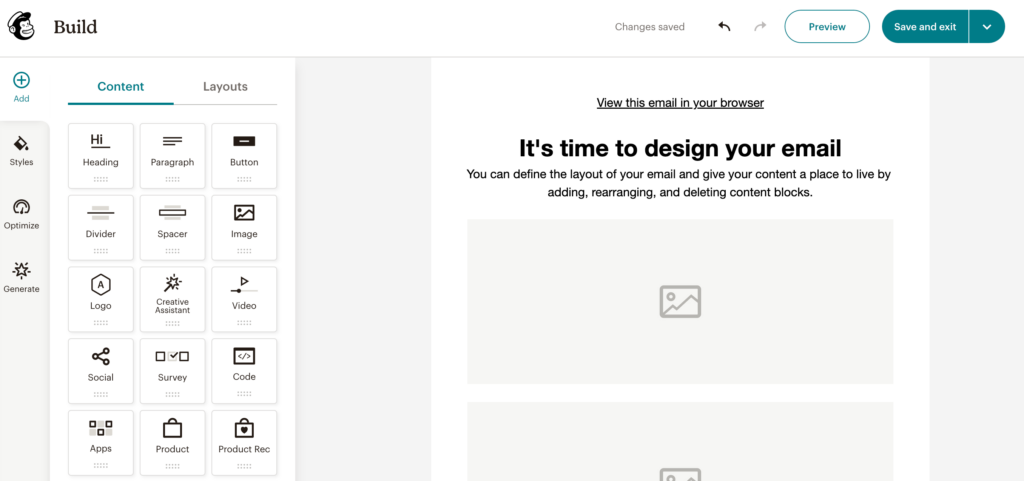
Mailchimp offers a user-friendly email builder and provide robust functionality. Moreover, the platform supports all types of email campaigns, including A/B tests and RSS campaigns.
On the contrary, Flodesk only supports regular email campaigns and automated emails. But its overall email builder makes up for this missing functionality.
Flodesk’s email wizard is one of the most organized we’ve seen. It guides you through a simple process: selecting a template, editing the design, and adding campaign details like the subject line, recipients, and sending time.
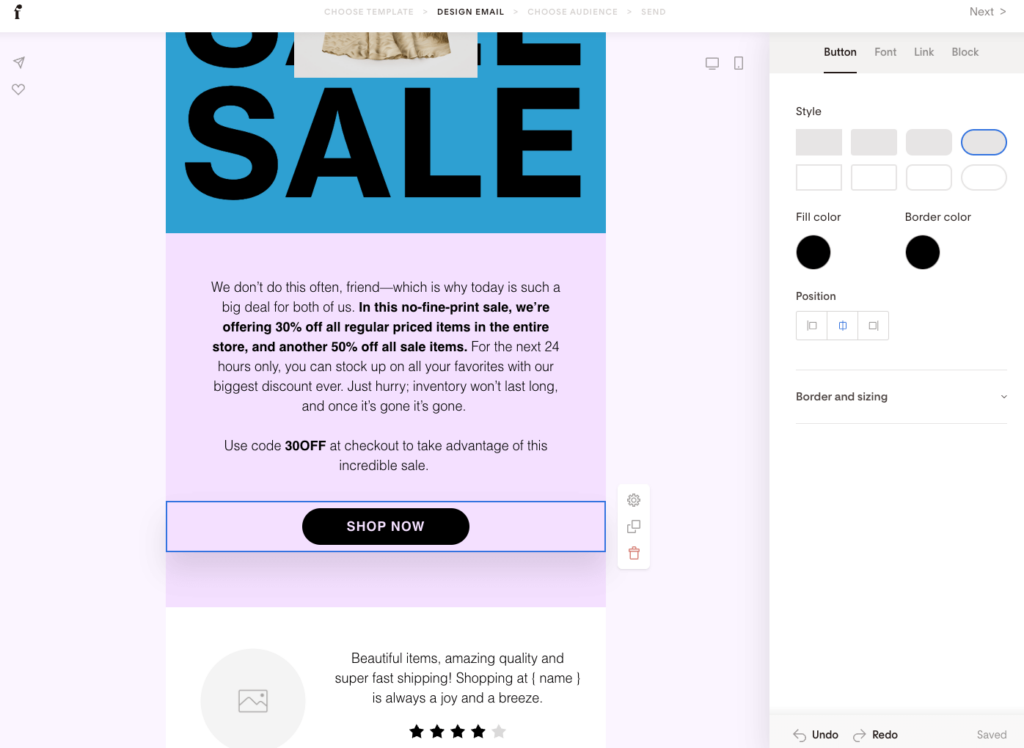
While Flodesk’s email design builder may have a unique appearance compared to other builders, it offers all the essential email elements. Plus, it’s pretty cool that users can conveniently embed images directly from Instagram.
Mailchimp’s email builders are no less, though. The only issue we found was removing the Mailchimp tag from emails, which can be complex.
Now, let’s discuss the templates. Flodesk’s templates are their standout feature; they are stunning and contemporary, adding a visually appealing touch to everything on the platform.
Mailchimp also provides good templates. You can work with blank templates called “layouts” if you desire more control over your email design. Sadly, the templates on its free plan are limited. There are only six options/layouts to choose from. So if you plan to use email templates, check Maichimp’s paid plans.
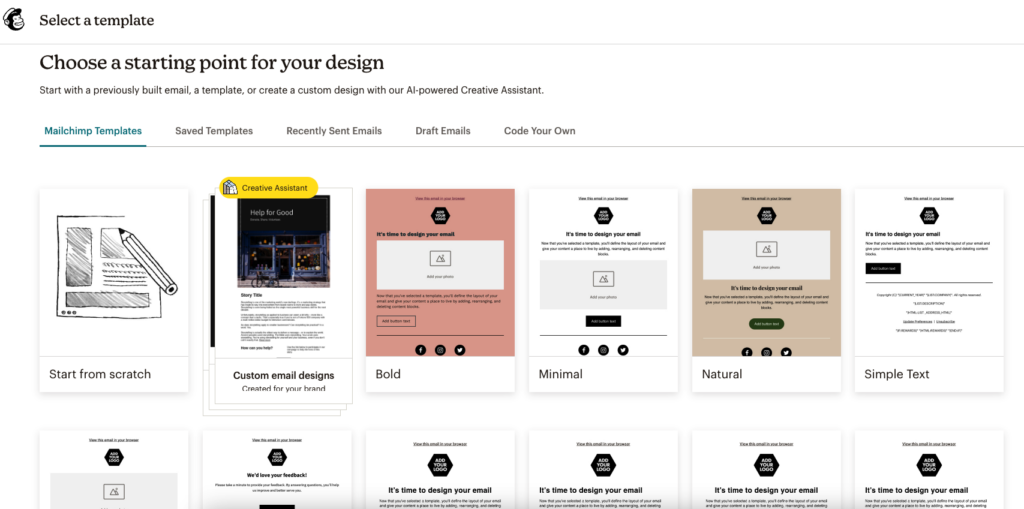
When it comes to personalization, Flodesk offers simple text personalization, while Mailchimp provides dynamic content blocks. However, both features can be a bit challenging to find and use without the support of the Knowledge Base.
We discovered Flodesk’s unique emphasis on visuals, allowing users to adjust image opacity directly in the editor. However, the platform needs to improve regarding advanced or ecommerce-focused features.
As for Mailchimp’s unique offerings, expect 25 tokens for inbox previews on various devices in integration with Litmus.
Flodesk leads with its sophisticated email builder and visually appealing templates. Nevertheless, Mailchimp presents tough competition in this comparison. If you need broader email functionality, go with Mailchimp.
Marketing automation
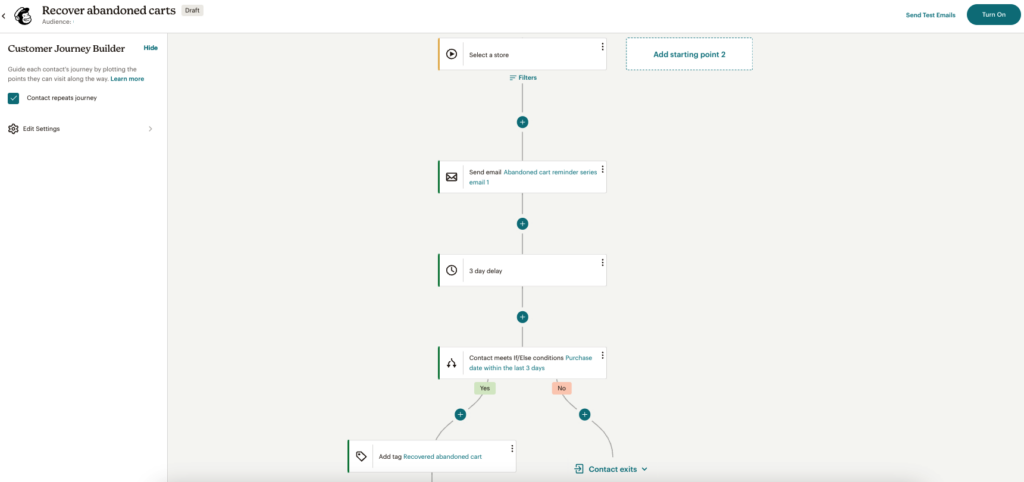
Both tools offer user-friendly editors for triggered emails, but Mailchimp holds an advantage over Flodesk. Let’s explore why:
- Triggers: Mailchimp provides numerous built-in triggers based on various events and actions. The only trigger Flodesk offers is when subscribers enter a segment.
- Pre-built workflows: Mailchimp boasts over 70 pre-built customer journey templates, including various social media channels and email sequences. In comparison, Flodesk offers a smaller selection of templates. These include welcome sequence, sales sequence, nurture sequence, and lead magnet delivery automation.
- Integrations: Mailchimp allows integration with social media platforms like Facebook, Instagram, and Twitter. On the other hand, Flodesk doesn’t support the integration of other marketing channels into its workflow.
- Analytics: Mailchimp’s Classic Automation Reports provide comprehensive statistics, including status, queue numbers, etc. In contrast, Flodesk’s analytics for automated journeys are limited.
Without a doubt, Mailchimp emerges as the clear winner, as it outperforms Flodesk in every aspect.
Signup forms and landing pages
Next, let’s look at the list-building capabilities of Mailchimp vs Flodesk.
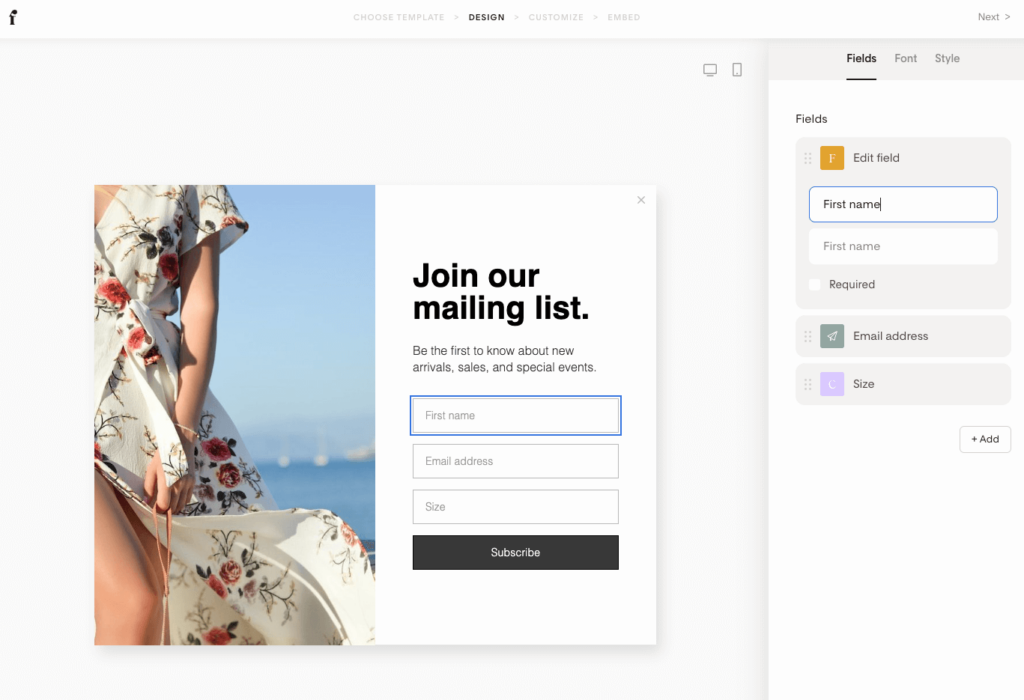
Both email marketing platforms offer audience-building capabilities through signup forms. Flodesk provides a variety of form types, including popup, inline, and full landing page forms.
Additionally, after subscribers sign up, Flodesk allows you to display a thank-you message or redirect them to a chosen landing page.
40+ modern templates are highly customizable. You can even add images from Unsplash, making forms more attractive for potential subscribers.
Meanwhile, Mailchimp lacks any pre-designed signup form templates. But it has one of the best landing page builders, offering nine customizable templates that users can easily tailor.
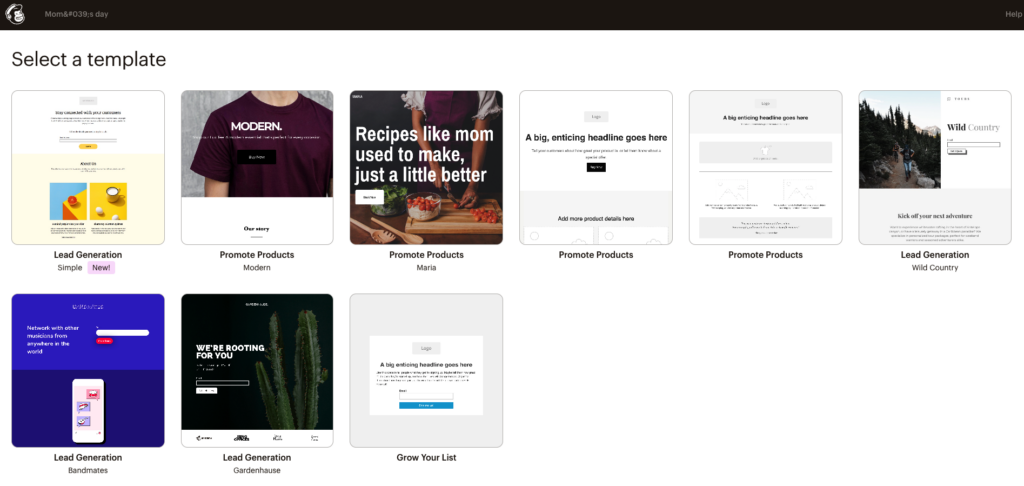
Flodesk’s landing page options are just as good. The templates are tailored for various purposes, such as selling digital products, offering educational content, presenting freebies, or creating a checkout page.
However, we found it odd that Flodesk’s terminology for landing pages is ‘checkouts.’
Speaking of limitations, Flodesk doesn’t have an automatic launch of forms to your website. Additionally, the popup settings are limited.
As for Mailchimp, it restricts users to only one popup at a time. As a result, integrating immediate popups with exit-intent popups isn’t possible.
List management
Managing lists on Mailchimp is straightforward, with convenient subscriber tagging and segmentation.
However, it’s rather disappointing that Mailchimp segregates lists. This means you pay for duplicate email addresses, including unsubscribed and inactive contacts.
Flodesk uses segments instead of traditional lists, which function similarly. Importing contacts is easy, and it meets industry standards.
Flodesk emerges as the winner in this round due to its more diverse and higher-quality templates and the inclusion of pre-built signup forms.
Segmentation
In this segment of the Flodesk vs Mailchimp comparison, we’ll examine both tools’ segmentation capabilities.
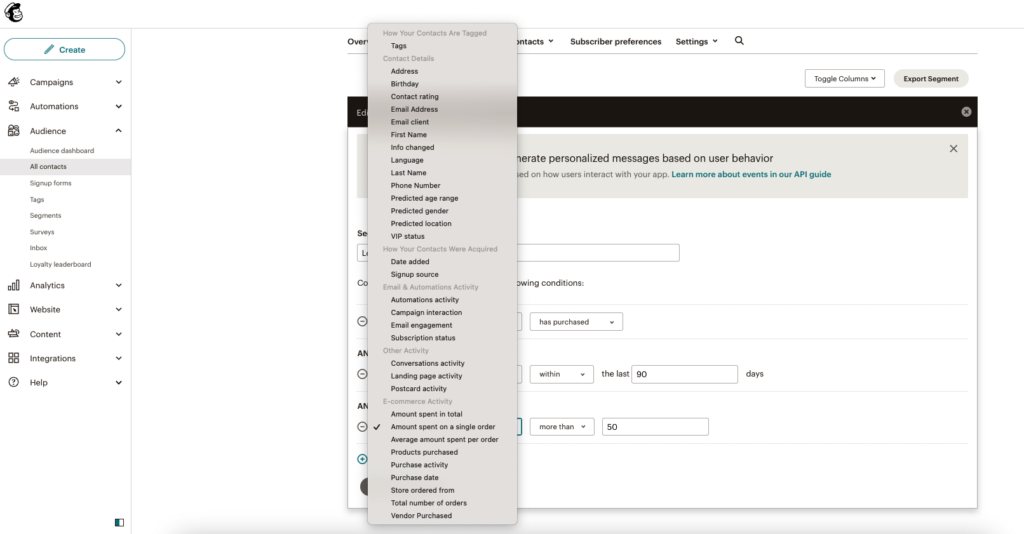
Mailchimp offers segmentation based on purchase history, order value, and specific product categories, making it a powerful tool for targeted marketing. Each segment allows you to add up to five conditions.
With Flodesk, things get tricky when you want to segment your audience. First off, the functionalities are pretty basic compared to Mailchimp.
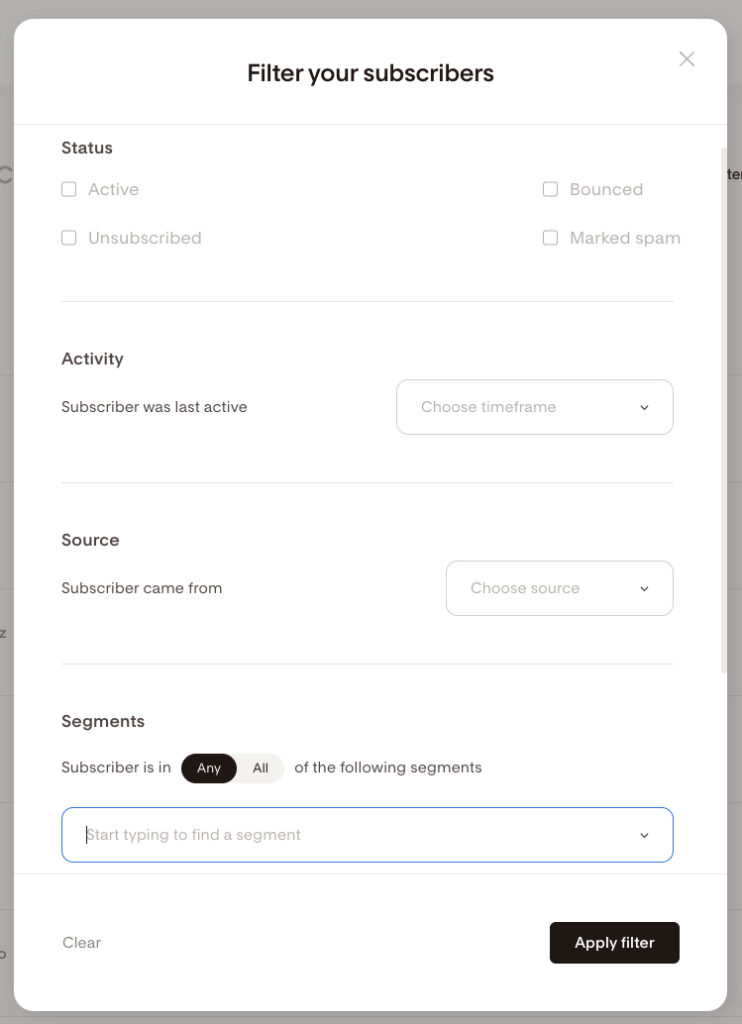
Instead of traditional lists, you create segments by applying filters on Flodesk. These filters include:
- Activity date and status
- Source
- Belonging to other segments
- Belonging to other data fields
Flodesk disappoints in terms of common segmentation criteria like demographics and email activity. These features need to be included in the platform.
Mailchimp wins this round. Despite requiring a steeper learning curve, Mailchimp provides extensive segmentation options.
Analytics
Flodesk or Mailchimp: Which platform offers better analytics?
Mailchimp’s analytics may not delve too deep into specific aspects compared to other ecommerce-focused platforms, but you can get insights on basic metrics such as:
- Open and click rates
- Campaign forwarding
- Social media engagement
- Landing page engagement
Premium plan users also access comparative reports that provide comprehensive insights from regular and RSS campaigns.
A Mailchimp feature worth mentioning is its ability to export data for a specific audience within a certain time frame. Their website report shows unique anonymous visits and their number of subscribers.
Flodesk’s analytics can be divided into three key sections:
- Automation: View active subscribers, entries, completions, open rates, click rates, and unsubscribe rates
- Email campaigns: Insights on email engagement, opens, and clicks by device
- Checkouts: Displays the number of visitors, orders, and total sales
In general, both tools provide essential campaign insights, but they need to catch up regarding predictive analytics, which is crucial for ecommerce businesses.
Mailchimp beats Flodesk in this round. It offers a wider range of data and more in-depth insights for advanced users.
Customer support
Mailchimp’s customer support varies based on the plan. Free users only receive email support for the first 30 days, while paid customers enjoy 24/7 email and chat support. Premium plan users get phone support with priority assistance.
We tested Mailchimp’s live chat support and found it prompt. Plus, there’s a content hub with valuable resources, including tutorials, blog articles, and YouTube videos in different languages. This is an excellent option for DIY enthusiasts.
Flodesk’s customer support is limited compared to other platforms. They don’t offer live chat or phone support, making their support options relatively modest. There’s only email support in the US from 6 am to 6 pm Eastern Time.
On the brighter side, the platform has an extensive online help center. This hub includes how-to videos, email marketing best practices, and platform guides.
Additionally, Flodesk University offers free video courses on email marketing strategy. It’s great that this is available to everyone without signup or registration.
Mailchimp takes the lead in this round. It doesn’t just offer multi-channel support but also a range of learning resources.
Integrations
Mailchimp boasts a vast selection of 300+ integrations, covering various categories such as:
- Ecommerce platforms
- CRM software
- Review platforms
- List building tools
At present, Flodesk provides direct integration options solely for Shopify, Instagram, Interact and Marvelous. Also, very easy to connect with Stripe for Checkouts.
However, whether you choose Mailchimp or Flodesk, you can integrate with Zapier. This connector will allow you to connect with thousands of other apps and ensure smooth workflows for your business.
In this round, Mailchimp wins due to its extensive range of native integrations.
Compatibility with other marketing channels
Compatibility with other marketing channels enables email marketing software to broaden its outreach. In this regard, Mailchimp fares well.
It allows seamless integration with channels such as:
- SMS
- Google Analytics
Sadly, Mailchimp doesn’t offer built-in push notifications. This is a bit disappointing considering its reputation for providing a wide range of functionality and integrations.
Currently, Flodesk doesn’t offer compatibility with any other marketing channels, making it a valuable platform primarily for email marketing purposes only.
Mailchimp takes the lead in this round as it offers compatibility with multiple marketing channels.
Generative AI tools
Mailchimp has introduced Intuit Assist with many different AI features to facilitate marketers’ routine tasks. This innovative tool helps marketers generate content and allows deep personalization.
Meanwhile, Flodesk doesn’t offer any AI solutions for now.
No doubts, it’s Mailchimp.
Price Comparison
As we near the end of this Flodesk vs Mailchimp comparison, let’s look at their pricing plans. Do the features they provide align with the costs?
Mailchimp’s pricing is rather complicated, whereas Flodesk offers straightforward plans depending on your desired features.
Let’s determine which option is more sensible.
Free plans comparison
Although Flodesk lacks a free plan, you can still explore its features through the generous 30-day free trial. During this period, you’ll enjoy unrestricted access to all the tool’s features.
Mailchimp, on the other hand, does come with a free plan. However, it’s specifically designed for marketers. If you own an ecommerce business, you’ll need to begin with a paid plan to gain access to ecommerce-friendly features.
Still, here are some of the functionalities you can access on the free plan:
- Audience dashboard
- Surveys
- Forms and landing pages
- Basic segmentation
- Facebook and Instagram ads
- Personalized product recommendations
- Social posting
- Basic reports
- Email support for the initial 30 days
Mailchimp’s free plan allows you to have up to 500 contacts in your mailing list and send up to 1,000 emails monthly. However, you can only send a maximum of 500 emails per day.
Once your contact count or monthly email sending exceeds the limitations of Mailchimp’s free plan, you’ll need to upgrade to one of their paid plans.
Paid plans comparison
Which software provides better value for money, Mailchimp or Flodesk?
We want to highlight a crucial difference from the start, as it will likely simplify your decision-making process.
Mailchimp follows a tiered pricing model. Its pricing is based on the number of subscribers you have and the features you need.
As you move up the tiers, the cost will increase, and you’ll gain access to more advanced features and higher subscriber limits.
In contrast, Flodesk uses a flat pricing model. This means they charge a fixed subscription fee that provides access to all features, regardless of the number of subscribers or the usage level.
Mailchimp’s plans may appear more reasonable due to their lower initial costs if you have a small subscriber list. However, it’s important to note that as your subscriber count grows, Mailchimp’s pricing escalates significantly.
To offer more flexibility, the platform also offers a pay-as-you-go model. This option particularly benefits users who send emails infrequently or have varying email marketing needs.
Flodesk offers three distinct plans to cater to different business needs. The Email plan addresses email marketing requirements, while Ecommerce plan is for creating effective checkout experiences.
Flodesk is perfect for minimalist email designs, email-focused features, and simple pricing. But if you prefer starting free and need more marketing functionalities, Mailchimp is a better fit.
Flodesk vs Mailchimp: Which one wins?
Before announcing the overall winner, let’s recap the features and pricing of Flodesk vs Mailchimp:
3.1
4.5
Flat-rate pricing model.
There are three plans based on the features you need, regardless of the number of subscribers.
Email plan – $38/month
Ecommerce plan – $64/month
500 subscribers – $13
1,000 subscribers – $27
5,000 subscribers – $75
10,000 subscribers – $110
50,000 subscribers – $385
– Paid plans only
– 30-day free trial
– 1,000 email sends/mo
– 1 seat
– 300+ integrations
– A few basic email templates
– Basic analytics
– Forms and landing pages
– Email support for 30 days
– No multivariate testing, advanced segmentation, and comparative reporting
– Beautiful designs
– Very easy to use
– Clean interface and intuitive design
– Wide range of features
– Lots of integrations; easy to integrate into any toolkit
– Very easy to use
– Basic automation and segmentation features
– No live chat or phone support
– A/B tests missing
– Charges for email duplicates – if a subscriber appears in two different lists, you’ll be charged extra
– Free plan with very limited features
– Paid plans get very expensive as the subscriber list grows
– Email templates on the free plan are very basic
– Bloggers
– Freelancers
– Educators
– Personal branding specialists
– Non-profit organizations
– Digital sellers
– Solopreneurs
– Startups
– Bloggers
– Non-profit organizations
– Ecommerce businesses of any size
– Growing ecommerce stores
Choosing between Flodesk vs Mailchimp shouldn’t be challenging, as they offer distinct differences in features and pricing models. With clear contrasts in their offerings, you can make a well-informed decision based on your needs.
For creative-based businesses starting with email marketing, Flodesk is an excellent option. However, if you seek advanced marketing features such as A/B testing, advanced automation, and compatibility with other channels, Mailchimp will probably provide more value.
Whether you opt for Flodesk or Mailchimp, both platforms may not fully meet your ecommerce needs. For more robust ecommerce-focused features, we suggest alternatives like Klaviyo, GetResponse, or Omnisend.
Read full reviews
Related picks for you
Our team strives to be accurate and unbiased in reviewing email tools. However, we recognize that mistakes can happen, and it’s essential for us to stay up to date. If you come across any errors or things that need to be reviewed again, please let us know.




